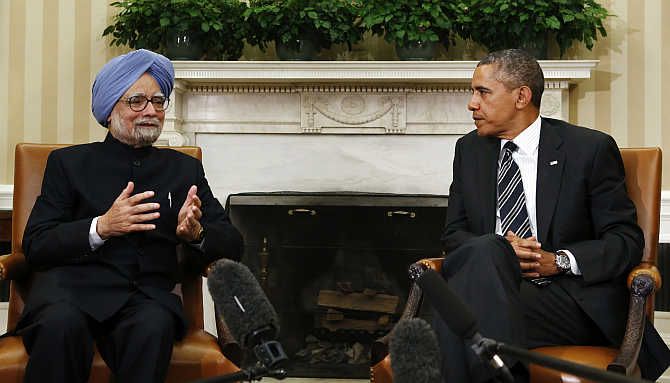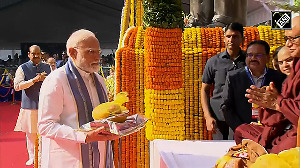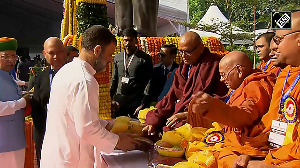 'India-US relations seem to have soured when the US expected India to not only balance China in the Asia-Pacific, but also make concessions to Pakistan as a price for US technological help,' says Colonel Anil A Athale (retd).
'India-US relations seem to have soured when the US expected India to not only balance China in the Asia-Pacific, but also make concessions to Pakistan as a price for US technological help,' says Colonel Anil A Athale (retd).
As the tumultuous year ended, India stares at even greater challenges on the security front in the coming year. Thanks to the United Progressive Alliance government's non-governance for the last 10 years, the Indian economy has lost steam while red tape and a holier-than-thou defence minister has ensured that the defence modernisation is stuck in Central Bureau of Investigation inquiries and a plethora of committees.
To boot, India seems at loggerheads with both China and the United States, a superhuman feat of failed foreign policy. Pakistan, Prime Minister Manmohan Singh's obsession, remains hostile as ever.
Against this backdrop, the American draw down of forces from Afghanistan is widely expected to lead to the brutal Taliban taking over the country with a likely spill over of jihadist violence in Pakistan and India.
The challenges (not threats because India is far too powerful to be threatened by any country) can be analysed at three levels: Global, regional and internal. This article intends to deal with challenges only at the global level.
India emerged as a major player on the global scene in the post 1991/Cold War era. The period also coincided with economic reforms unleashed by then prime minister P V Narasimha Rao that saw India become the fourth/fifth largest economy (in Purchase Power Parity terms). The Indian position was further enhanced when in 1998 it went overtly nuclear (it had been a covert nuclear power since 1974).
Unfortunately for India, its ruling elite still do not understand Indian strength and are still stuck in 'Third Worldism'. Unlike during the Cold War when it was at best a spoiler in Asia, today it is seen as a rival pole vis-a-vis China.
This policy weakness is exacerbated by the structural weakness of its foreign policy establishment that remains tiny (even the city State of Singapore has a bigger foreign service), insulated, dominated by nepotism and has only a dim understanding of military, cultural and economic dimensions of foreign policy.
In many aspects, it is still stuck in the Nehruvian model of moralist pretensions and is reluctant to play the power game. Much of the Delhi-based foreign policy elite is also not fully in sync with the Indian civilisational ethos that can be a source of great strength for soft power.
During the just ended year China has been routinely needling India on the Ladakh border and laying claims to the state of Arunachal Pradesh. India's belated moves to build infrastructure on its border and intention to create an 'offensive' capability is unlikely to check the Chinese.
The Chinese seem to have concluded that they can keep India at bay by pinpricks on border and skilful use of its proxy Pakistan. To a large extent, Chinese adventurism is fuelled by the uncertain India-US friendship.
The biggest challenge in the coming year may well be the future of the India-US 'alliance' that never was. India does not seem able to make up its mind whether it wants to be a US ally, partner or a mere friend.
The recent fracas over the arrest and ill-treatment of an Indian diplomat in the US is not the cause but symptom of what is wrong with India-US relations.
The reason for this mutual disappointment is that India expected to get a military technology edge with American help since it has to balance China. While for the US, this help has to be balanced by the unease in Pakistan, an ally it needs in the Middle East.
India-US relations seem to have soured when the US expected India to not only balance China in the Asia-Pacific, but also make concessions to Pakistan as a price for US technological help.
As the US tries to find a quick fix solution to Afghanistan by cosying up to the Taliban, Indian interests are likely to diverge from those of the US. This is a repeat of the 1962/1963 scenario when the nascent India-US alliance foundered on the rock of American interests in the Middle East for which Pakistan is a necessary proxy.
President Barack Obama, as a presidential candidate, had openly advocated these thoughts. It seems this is still the basis of US approach to India although covertly.
The fundamental cause of the India-US relations languishing is the inability/unwillingness of the Americans to understand/accept the power-shift on the world stage and also within India.
It is not that American power has 'declined' per se. But if 'power' is to be understood as the 'difference in strength,' then the fact that the other countries's power has increased means reduction in the difference in relative power.
As US political scientist Joseph S Nye said, great powers do not adjust to circumstances, but instead alter the circumstances to suit their ends.
Clearly, the US has passed that stage sometime in the first decade of the 21st century, while it continues to behave as if this has not happened. Even within India, the US's ability to influence the electoral outcome/policies is strictly limited, although it can attempt to steer Indian politics with a combination of economic, IT industry and NRI (Non Resident Indians) lobbies. But there are limits to this since outsourcing/economic ties are not a one way street.
At best, these lobbies can do damage control, as they did during the Cold War. India-US relations in the coming year may well resemble those between Brazil and the US, but not quite Venezuela.
Interestingly, this is not a throwback to the Cold War era when the US interest in India was negative: It should not go Communist, but positive in that a strong India, whether a US ally or not is existentially a check on a rising China.
Given Chinese intransigence, the US can afford to take India for granted. Given the Chinese aggressive posture in East Asia, India will continue to come closer to South East Asia and Japan.
The challenge for India will be to manage these relations without aggravating its economic relations with China.
In the noise created by incidents in East Asia, a crucial fact has gone un-noticed: The re-rise of Russia.
Russia successfully defended its ally in the Middle East, Syria, and thwarted the North Atlantic Treaty Organisation nations and the European Union from expanding to Ukraine.
Though Sino-Russian relations are cordial, Russia cannot overlook the long term threat to its far eastern empire and Siberia from a growing China.
Surely Russia does not wish to be China's Canada! In that sense, like the US, Russia would also look to India to balance China in Asia.
The challenge before India is to strike a fine balance between these competing interests. No diplomacy can work unless India sets its economic house in order and carry out much delayed reforms of the defence production/research sector to lend muscle to Indian diplomacy.
The work for the new government that takes over in May is well cut out.
Image: Prime Minister Manmohan Singh with US President Barack Obama in the White House on September 27, 2013. Photograph: Kevin Lamarque/Reuters
Colonel Anil A Athale (retd) is coordinator of Indian Initiative for Peace, Arms-control & Disarmament, a Pune-based think tank.











 © 2025
© 2025